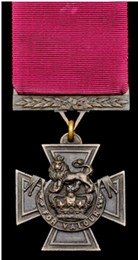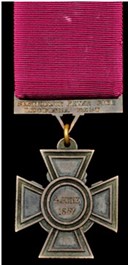FIRST VICTORIA CROSS AWARDED TO A NON COMMISIONED OFFICER OF THE INDIAN ARMY TO GO UNDER THE HAMMER AT SPINK

FIRST VICTORIA CROSS AWARDED TO A NON COMMISIONED OFFICER OF THE INDIAN ARMY TO GO UNDER THE HAMMER AT SPINK

London. October 23, 2012. Spink announced today that it will offer for sale the Indian Mutiny V.C. awarded to Sergeant Major (later Lieutenant) Peter Gill of the Loodiana Regiment. The Victoria Cross, which is the highest military decoration bestowed for bravery and gallantry in the face of the enemy, was presented to him for saving the life of an officer and his family at Benares and seeing off 27 mutinous Sepoys with only his Sergeant's sword, on the 4th June, 1857.
It is the first ever V.C. to be awarded to a non-commissioned officer in the Indian Army, and also the first ever V.C. to a Sikh Regiment. The medal will be offered for sale in Spink's upcoming auction of Orders, Decorations, Campaign Medals and Militaria, on Thursday, November 22, 2012 at Spink in London.
On 23.8.1858 The London Gazette printed the following: 'This non-commissioned officer conducted himself with gallantry at Benares, on the night of the 4th June 1857. He volunteered, with Sergeant Major Rosamond, of the 37th Regiment of Bengal Native Infantry, to bring in Captain Brown, Pension Paymaster and his family, from a detached bungalow into the barracks and saved the life of the Quartermaster-Sergeant of the 25th Regiment of Bengal Native Infantry, in the early part of the evening, by cutting off the head of the Sepoy who had just bayonetted him. Sergeant-Major Gill states, that on the same night he faced a guard of 27 men with only a Sergeant's sword; and it is also represented that he twice saved the life of Major Barrett, 37th Regiment of Bengal Native Infantry, when attacked by Sepoys of his own regiment.'
Commenting on the importance and rarity of this V.C., Spink medal specialist Oliver Pepys said:
"This V.C. is hugely important for, not only does it give us great historical insight into the period and the outstanding acts of courage and single-handed gallantry displayed during the Mutiny, it is the first awarded to a Sikh Regiment, whose loyalty and bravery were subsequently unsurpassed, and whose men served this country with such distinction for almost a century, from the depths of the Mutiny to victory on the Road to Mandalay. It is certainly a well-earned Cross"
Although it is hard to look at such a historic piece in monetary terms, the pre-sale estimate has been put at £80,000-£100,000. However, with other Victoria Crosses recently sold by Spink achieving high prices, Spink specialists think this V.C. may well realise more than the estimate.
~ENDS~

Notes to Editors
Spink holds the record for the highest price achieved at auction for a V.C. Group to a British recipient: The Victoria Cross group to Flight Lieutenant Bill Reid, Royal Air Force, which realised £348,000 in November 2009.
Spink also holds the world record for a single Victoria Cross sold at auction. The V.C. which was awarded to Rear-Admiral John Bythesea sold for £155,250 in 2007.
About Sergeant Major Peter Gill, V.C.
He was born Dublin in 1816 and after leaving school trained as a tailor. Moving to London he enlisted for service with the Honourable East India Company in the Bengal Artillery, February 1842, and sailed for India aboard the H.E.I.C. SteamshipHenry. Upon his arrival in India he was posted to 5th Company, 3rd Battalion, Bengal Artillery as a Gunner, and served with the Artillery in both the First and Second Sikh Wars, and was awarded both the Sutlej and Punjab Medals, before transferring to the Loodiana Regiment of Sikhs as Sergeant Major in April 1850.
Mutiny at Benares
The Great Sepoy Mutiny started at Meerut on the 10th May 1857, and before the month was out unrest had spread across large parts of northern India. Reports of the mutinies had made the large 'ruffian population' of Benares, many of whom openly carried arms, even more volatile than usual, and fearing a civil uprising the Commissioner, Henry Tucker, and the temporary Station Commander, Colonel Patrick Gordon, Loodiana Regiment, proposed evacuating the garrison, comprising of the Loodiana Regiment, the 37th Native Infantry under Lieutenant-Colonel Arthur Spottiswoode, a wing of the 13th Irregular Cavalry, and a half battery of European Foot Artillery, to the nearby stronghold at Chunar. However, owing to the importance of securing the road, river, and telegraph links between Calcutta and upper India, it was decided to stay put in the town, and re-enforcements were called for.
News of the Azimgarh mutiny reached Benares during the afternoon of the 4th June- by this time European Garrison had been reinforced by 150 men of the 10th Foot, and 60 men of the 1st Madras Fusiliers, under the command of Lieutenant-Colonel James Neill. Immediately upon arriving in Benares Neill was determined to disarm the 37th N.I., the most suspect regiment in the town. Despite the reservations of the Officers of the 37th, including their
Commanding Officer, Lieutenant-Colonel Spottiswood, and Major Barrett, who was convinced that the Regiment would remain loyal, Neill got his way and At 5:00pm the disarmament parade began. However, the preparations had been so hurried that that none of the supporting European troops was in position by the time the command was given, and one company after another came up to lodge their muskets in the bells-of-arms. As No. 6 Company were lodging their arms the advance guard of the 10th Foot, accompanied by a number of guns, appeared on the parade ground. A cry went up from the 37th N.I.: 'Our officers are deceiving us, they want us to give up our arms, that the Europeans who are coming up may shoot us down!' (The Indian Mutiny, Saul David refers). Pandemonium broke out.
The Sepoys rushed forward to reclaim their muskets from the bells-of-arms, and opened fire on the nearby European troops, who replied with rifle and accurate artillery and grape fire. Meanwhile the Officers of the 37th were seeking safety with the guns, with the exception of Major Barrett who, believing that his troops had been most unfairly treated, cast in his lot with them and was carried away by Sepoys of his own Regiment. Several Europeans were hit in the ensuring fight, and command soon devolved to Colonel Neill, who ordered the European and Sikh troops to charge the lines of the Sepoys. In the confusion, sowars of the still-loyal 13th Irregular Cavalry shot in the direction of the Sikhs, who faced about and returned fire. Assuming that the Sikhs had mutinied, the European gunners opened fire on them, causing the whole Regiment to scatter.
Fighting continued into the evening; those mutineers who had sought shelter in the Lines were driven out and destroyed, whilst a few who succeeded in hiding themselves were burnt to death in their huts. During the operations Gill volunteered along with Sergeant-Major Rosamond, 37th N.I., to collect to safety the Pension Paymaster and his family, who were cut off in an isolated detached bungalow, which the mutineers had set on fire. He also claimed to have twice saved the life of Major Barrett, who having entrusted his life to the men of his Regiment soon found himself under attack by mutinous sepoys. For these acts of Gallantry Gill was awarded the Victoria Cross, the first V.C. to be awarded to a Non-Commissioned Officer of the Bengal Army, and the first to a Sikh Regiment.
Commissioned Ensign in the Moradabad Infantry Levy on the 16th April 1858, Gill served with his new Regiment for the rest of the Mutiny until frontier operations in Oudh came to an end in April 1859, and he was presented with his Victoria Cross later that year in India. Promoted Lieutenant, Indian Establishment, in May 1863, he served as Lieutenant on Duty at Lucknow for the next four years, before being appointed Barrack Master (1st Class) at Morar, Gwalior, on the 21st October 1867. Lieutenant Peter Gill died at Morar a year later on the 24th October 1868, aged 52, and is buried in the Artillery Lines Cemetery, Gwalior, India.



